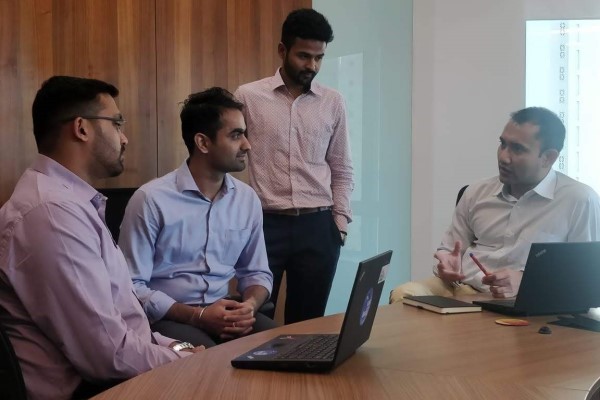Clinical trials: A story from bench to bedside

- Magazine
- Access to innovative health solutions
-
Covid-19
- Increased COVID-19 support for India
- Stronger Together in the fight against Covid-19
- Growing Enough during the Coronavirus Pandemic
- LIFE Stronger than lockdown
- Lessons for malaria elimination from covid-19
- The IT Army: catapulting digital change
- Safety at Vapi during Covid19
- Communications during covid-19
- Smallholder farmers and food security
- Digitalization
- Doubling farmers income
- Make in India
- People & Blogs
- Societal Engagement
- Sustainable agriculture
It’s amazing what wonders a molecule can work – it can quickly make your pain disappear or sometimes make you feel more energetic. But have you wondered what goes behind putting together that magic potion in a drug? From the time you read about a discovery to the time that you can actually purchase the product, there’s a lot that happens. Subrata Bose, Global Head - Clinical Trials Analytics and Insights, Bayer talks about the need for a data driven approach to help reduce this time-lag.
It all starts with the discovery of a molecule that has the potential to combat a disease. You will proceed with the development if there are no existing treatments or if it is more effective or economical than the current alternatives. But more importantly, for any new drug to reach the market, it is crucial to monitor and ensure its safety. This is why potential new therapeutic approaches are subject to clinical trials. These are done in a phased manner that begins with drug research in a lab, preclinical testing on cell lines or animals, clinical trials on healthy volunteers followed by growing batches of patients to a deep dive into clinical trial analytics and finally applications for approvals from different markets.
If you consider this entire backstage process, it takes approximately 15 years for an idea to reach the market and around a billion euros of investment. To give you a better picture – there are 4 million compounds of which only about ten thousand proceed to research in the initial stage and then maybe 250 or less are extended for pre-clinical testing. Eventually only 5 compounds are studied in clinical trials and maybe just one may reach the market.
To support research and development of this kind which involves colossal amounts of investments in terms of time and money, it needs to supplemented with a well-defined plan for the clinical trials. You begin with writing the ‘protocol’ or ‘recipe’ that describes what will be done in the trial, how it will be conducted, how many participants are needed, what is the regime and why each part of the study is essential. Everything is planned very carefully to keep participants as safe as possible – in fact, I have also participated in a clinical trial as a healthy volunteer much before I joined Bayer. An informed consent is required from all participants in addition to ethics approvals from various health authorities. This may differ from country to country – some have a centralized approval system while in others, each hospital could have its own ethics committee. It takes years to complete a clinical trial, sometimes extending much longer than its participants – it all depends on how long it takes to collect the required information.
The sooner you bring a molecule to the market, the sooner patients can benefit from the new treatment. From a company’s perspective, its also the first to market advantage when it comes to a new therapy. But for this to happen, you also need to be able to get the right patients at the right time and at the right hospital - this is one of the key challenges faced by the industry today. Every clinical trial begins with an estimated timeline, but a lot of trials close pre-maturely as they fail to recruit the number of intended patients.
How does data help?

Data analytics and digitalization is now changing the way we conduct business. We now spend more time on electronic devices than we used to in the past. At the same time, we are witnessing leaps in life sciences like 3D printers, bio-printing as well as breakthrough innovations like genome or gene-editing. When you bring in artificial intelligence with this progression, there is a very positive future for all aspects including clinical trials. Recent investment in Advanced Analytics and process reengineering in Clinical Operations have improved our operational planning and trial execution ability. Clinical Trial Sites (Hospitals/Clinics) are being selected based on data driven insights, protocols are being optimized based on Standard of Care and real world evidences and planning is being done in an adaptive manner through mathematical modelling. As a result, most of our ongoing studies have been recruiting as planned or better and majority of the recent studies completed recruitment on time or earlier than baseline plans.
We have a team of data scientists and analytics managers spread across Europe, USA and India who are focused on leveraging data, analytics and benchmarking to drive strategies, decision making and the operational planning of clinical trials. We set up the India team in 2017 where the experts are trained in complex value chain of drug development and programming and help to generate insights from complex sets of data, set the key performance indicators needed in the protocol. We also continuously monitor if the studies are progressing well and country performances. We have now been able to effectively reduce the cycle time from bench (labs) to bedside by using analytics to find investigators and sites which have the right patients for a product trial. In the end, we are able to bring our drugs faster to patients.






